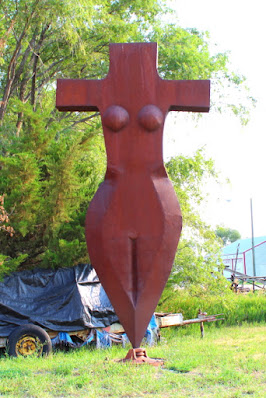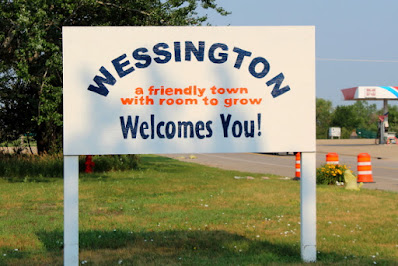 |
| Sunrise over the Farm |
It had been a long time since I had driven around central South Dakota; so one day while we were at the farm I decided to get up early one morning and drive to Huron (about 100 miles to the east of Pierre). Rather than return back to the farm by the same road, I drove north and looped back by way of Faulkton and Gettysburg.
On the way to Huron I stopped by a roadside marker about 20 miles east of Pierre that was located on the West 100-Degree Meridian. Historically, the West 100-degree Meridian was significant because that was considered to be the north-south dividing line between the humid Eastern and arid Western parts of the United States. Insurance Companies and other world-wide lending agencies would not "lend a shiny dime west of this line" because it was considered to be the east edge of the Great American Desert. This unrealistic geographically limiting loan policy forced the State of South Dakota into the farm loan business. Unfortunately, the State did not know anything about making farm loans and lost large amounts of money when farmers defaulted on the loans. The State had to borrow money to just continue operating. Eventually the State paid back all of the money that they had borrowed, and they did it without filing for bankruptcy.
About the same time that the State was paying off its loans, farm loan restrictions on the west side of the 100-degree Meridian were lifted and large Eastern banks and insurance companies stepped in to make farm loans.
Traveling east on US Highway 14, I drove through the communities of Blunt (population 354 - See Blog #0471), Harrold (population 124), and Holabird (almost a ghost town), before arriving at Highmore (population 717).
Outside of Holabird I passed by an interesting repurposed school bus. The back of the bus had been cut off, the frame shortened, and a hydraulic lift had been added to the back of the bus. The bus was being used to move large round bales of hay that usually weigh between 600 and 1,200 pounds. The hauler appeared to work really well. Since there is a large supply of old school buses, more farmers and ranchers should consider this conversion.
Along the highway that runs through Highmore was a historic marker explaining that Highmore received its name because it was the highest point on the railroad between Chicago and the Missouri River. When I was in High School there was a large International Harvester dealership in Highmore, so I frequently had to drive there to pick up parts that we could not find in Pierre.
 |
| Water Tower in Harrold |
 |
| Repurposed School Bus |
 |
| Historic marker in Highmore |
 |
| Water Tower in Highmore |
In 1880 the Chicago and Northwestern Railway Company completed railroad tracks from Huron to Pierre and along the way they designated rail sidings at Highmore (Number 5), Ree Heights (Number 4), and St. Lawrence (Number 3). The railroad intentionally spaced the sidings so that they were not too close together.
Ree Heights (population 62) is now the home of two-time World Champion Saddle Bronc Rider Robert Ethauer.
In 1881 Henry Miller, a conniving flim-flam man from Blairstown, Iowa, purchased 40-acres of land two miles west of St. Lawrence and founded the community of Miller. Henry had a friend that worked for the railroad and his friend convinced the railroad to build another siding and depot in Miller, even though Miller was only two-miles west of St. Lawrence.
In 1882 a heated battle broke out between St Lawrence and Miller to see where the county seat would be located. After a campaign that saw "bribery, trickery and bitter words," Miller was chosen because the town offered to build a new courthouse. However, after winning the election, Miller forgot about their courthouse offer.
Since Miller did not build the promised courthouse, in 1888 St. Lawrence was able to bring the county seat location to another vote. St. Lawrence won the vote, but the previous year the legislature had passed a law that required a two-thirds majority to move a county seat. Since St. Lawrence did not have a two-thirds majority, the county seat remained in Miller, where it is still located today.
During WW II Harian J. Bushfield from Miller was Governor and he successfully reduced State spending, cut sales and property taxes, and lobbied to end the State Income Tax. Thanks to Bushfield from Miller, South Dakota is one of the few states that still does not have a State Income Tax.
Miller (population 1,367) is now home of the school district's World Famous Rustlers - The most feared sports teams in South Dakota. (Well, at least that is what my sister-in-law told me.) Since there is currently no passenger rail service in Miller, the old train depot has been converted into a museum.
Although St. Lawrence (population 198) was not successful in moving the county seat, works of art on display would indicate that at one time there was a Playboy club located in the community.
Wessington (population 170) has a really big archery range and I had planned to stop for some archery practice, but I forgot to bring my archery equipment. Wolsey (population 376) was once featured on Forensic Files. The program was about a case in which the pastor of a local church was accused of murdering his wife in 1999. I did not ever see the program, so I do not know the case outcome.
For a small town in South Dakota, a number of notable people have affiliations with Wolsey. Richard Sears, who started Sears & Roebuck Company, was the Wolsey depot station manager for the C&NW Railroad. Adolph Friese invented a machine to make cement blocks. Richard Sejnoha opened a bakery in Wolsey and patented the Universal Bread Sealer. W.W. Howes became the First Assistant Postmaster General of the United States and secured commercial air service for South Dakota. The Huron Airport is named for him. Dr. M.E. Cogswell moved to Wolsey in 1907 and delivered over 1,500 babies during his 53 years of practice. Quite a list of accomplishments for a town with a population of 376.

Huron (population 14,280) was considered to be a really large city when I was growing up - population of about 12,000 at that time. It was possible to find anything you wanted in Huron. I remember one time in 1957 we could not find a suit that fit me in Pierre, so my Mother drove me to Huron where she purchased my first store-bought suit. I also saved my money so that when we went to Huron I could purchase a giant Sugar Daddy candy bar. It weighed about a pound and costs 75-cents. I would brake the candy bar into small pieces so that it would last me for several months.
The South Dakota State Fair is located in Huron and it was an annual family outing. Mother would get up really early in the morning and cook a large batch of fried chicken in her heavy cast iron skillet, which was packed in a wooden box and taken along with other picnic supplies. At lunch time the chicken would still be warm. Against my Mother's desires, we always went to the fair on the day they had the stock-car races in the afternoon and then we stayed for a program in the evening - usually something boring like Lawrence Welk.
The fair's midway had all of the latest farm equipment on display and women were given a free wooden yard stick just for visiting the area. The carnival rides were also located on the midway.
Some years we had 4-H exhibits on display, so we would tour all of the exhibit buildings. The Fish & Wildlife Department has a permanent building on the site that contained some really large fish on display in various tanks. We always dreamed of catching one of those large fish.
I drove by the Fair Grounds on my trip to Huron, but the facilities did not look like I remembered them. The old Dairy Building is now the Dakotaland Museum and a small train locomotive has now been placed in front of the building. Just down the street is a statue entitled "The Sower." by artist Frank Yaggie. The statue was donated by the artist to the commemorate the Centennial State Fair in 1884.
The Huron downtown area has deteriorated over the years; however, there appears to be some urban renewal going on in an attempt to bring more people to the downtown area. A number of nice murals have been painted on some of the buildings.
The historic "Largest Pheasant In The World" still stands at the edge of town, along with a large white buffalo. A military airplane is mounted on a pedestal in front of the Air National Guard Headquarters.
When I saw the white buffalo, it reminded me that when I was a kid I went to a really sad western movie. In the movie, Stewart Granger (Hollywood actor) shot and killed the last white buffalo. The white buffalo was considered to be sacred and spiritually significant to the American Indians.





































No comments:
Post a Comment